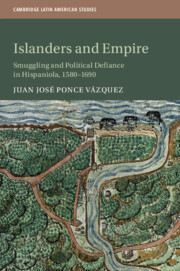Book contents
- Islanders and Empire
- Cambridge Latin American Studies
- Islanders and Empire
- Copyright page
- Dedication
- Contents
- Figures and Tables
- Acknowledgments
- Additional material
- Introduction
- 1 Colonial Origins: Hispaniola in the Sixteenth Century
- 2 Smuggling, Sin, and Survival, 1580–1600
- 3 Repressing Smugglers: The Depopulations of Hispaniola, 1604–1606
- 4 Tools of Colonial Power: Officeholders, Violence, and Exploitation of Enslaved Africans in Santo Domingo’s Cabildo
- 5 “Prime Mover of All Machinations”: Rodrigo Pimentel, Smuggling, and the Artifice of Power
- 6 Neighbors, Rivals, and Partners: Non-Spaniards and the Rise of Saint-Domingue
- Conclusion
- Glossary of Spanish Terms
- Bibliography
- Index
- Other Books in the Series (continued from page ii)
1 - Colonial Origins: Hispaniola in the Sixteenth Century
Published online by Cambridge University Press: 23 October 2020
- Islanders and Empire
- Cambridge Latin American Studies
- Islanders and Empire
- Copyright page
- Dedication
- Contents
- Figures and Tables
- Acknowledgments
- Additional material
- Introduction
- 1 Colonial Origins: Hispaniola in the Sixteenth Century
- 2 Smuggling, Sin, and Survival, 1580–1600
- 3 Repressing Smugglers: The Depopulations of Hispaniola, 1604–1606
- 4 Tools of Colonial Power: Officeholders, Violence, and Exploitation of Enslaved Africans in Santo Domingo’s Cabildo
- 5 “Prime Mover of All Machinations”: Rodrigo Pimentel, Smuggling, and the Artifice of Power
- 6 Neighbors, Rivals, and Partners: Non-Spaniards and the Rise of Saint-Domingue
- Conclusion
- Glossary of Spanish Terms
- Bibliography
- Index
- Other Books in the Series (continued from page ii)
Summary
This chapter offers a brief overview of the multiple transformationsthe island went through with the rise and fall of the colonial economy in the sixteenth century, as it cycled through gold extraction, and then the expansion of African slavery with the establishment of sugar plantations, all the while exploiting indigenous labor. After the decline of the sugar economy, ginger and cattle ranching followed as the most important economic activities in the last two decades of the century. The chapter ends with a description of the city of Santo Domingo as the social and political center of the colony.
Keywords
- Type
- Chapter
- Information
- Islanders and EmpireSmuggling and Political Defiance in Hispaniola, 1580–1690, pp. 22 - 55Publisher: Cambridge University PressPrint publication year: 2020

